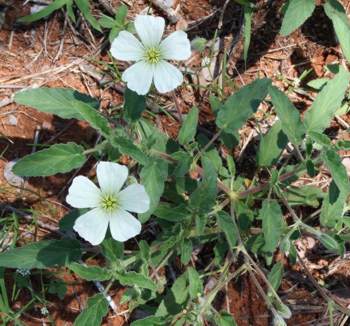Monsonia glauca
Monsonia glauca Knuth
Family: Geraniaceae
Common names: dysentery herb (Eng.); naaldebossie, keitabossie, keitabossie (Afr.).
Introduction
This is a perennial herb with a woody base growing in scrubby grassland.

Description
Description
Monsonia glauca is an erect, decumbent or prostrate, perennial herb up to 400 mm tall, with a woody base. Stems are densely covered with gland-tipped hairs. Leaves are opposite, ovate, basal mostly folded along midrib, cordate at base, with toothed margins. Flowers are white or creamy with dark greenish veins, with petals shallowly lobed at the apex. Fruits are held erect, 65-100 mm long.

Conservation Status
Status
Monsonia glauca is Red-Listed as LC (Least Concern) by Raimondo et al. in 2009
Distribution and habitat
Distribution description
Monsonia glauca occurs in the four northern provinces of South Africa, Limpopo, North West, Gauteng and Mpumalanga, and also in the northern Eastern Cape. The habitat is grassland and bushveld in the summer rainfall interior of South Africa. The distribution of Monsonia glauca extends beyond Namibia, Botswana and Zimbabwe, well into tropical Africa, including Kenya.
Derivation of name and historical aspects
History
The genus Monsonia was named after Lady Anne Monson (1714-1766), great granddaughter of Charles II of England, botanical collector who collected plants in India (Bengal) and South Africa (Cape of Good Hope) with Thunberg and Masson. The species name glauca is Latin for glaucous or bluish-green.
Ecology
Ecology
Monsonia glauca grows amongst grasses at an altitude of 600-1700 m, in scrubby grasslands, or in mopane woodlands, on stony soils.

Uses
Use
Although the common name dysentery has been applied to these herbs the medicinal use of the plants could not be established. It is presumed that the plant could not be a cause of dysentery (Blundell , 1987; Manning , 2009 )
Growing Monsonia glauca
Grow
Monsonia glauca is easily grown from seed although it is not commonly cultivated as a horticultural plant.
References
- Bailey, L.H. & Bailey, E.Z. 1976. Hortus third , edn 1: 3. Macmillan, New York.
- Bruneton, J. 1999. Toxic plants: dangerous to human and animals. Lavoisier Publishing, France.
- Dreisbach, R.H. 1971. Handbook of poisoning. Lange Medical Publications, Los Altos.
- Hardin, J.W. & Arena, J.M. 1974. Human poisoning from native and cultivated plants. Duke University Press, Durham.
- Hutchings, A., Scott, A.H., Lewis, G. & Cunningham, A. 1996. Zulu medicinal plants: an inventory. University of Natal Press, Pietermaritzburg.
- Moll, E., Moll, G. & Strebel, R.C. 1989. Poisonous Plants. Struik, Cape Town.
- Palmer, E. 1985. The South African Herbal. Tafelberg, Cape Town.
- Raimondo, D., Von Staden, L., Foden, W., Victor, J.E., Helme, N.A., Turner, R.C., Kamundi, D.A. & Manyama, P.A. (eds). 2009. Red List of South African plants. Strelitzia 25. South African National Biodiversity Institute, Pretoria.
- Roberts, M. 1990. Indigenous healing plants. Southern Book Publishers, Halfway House.
- Smith, C.A. 1966. Common names of South African plants. Memoirs of the Botanical Survey of South Africa No. 35. Government Printer, Pretoria.
- Watt, J.M. & Breyer-Brandwijk, M.G. 1962. The medicinal and poisonous plants of southern and eastern Africa, 2nd edition. Livingstone, London.
Credits
Thabo Masupa
National Herbarium, Pretoria
September 2014
Plant Attributes:
Plant Type: Perennial, Shrub
SA Distribution: Eastern Cape, Limpopo, North West
Soil type: Sandy, Loam
Flowering season:
PH: Acid, Neutral
Flower colour: Green, White, Cream
Aspect: Full Sun
Gardening skill: Average
Special Features:
Horticultural zones







Rate this article
Article well written and informative
Rate this plant
Is this an interesting plant?
Login to add your Comment
Back to topNot registered yet? Click here to register.